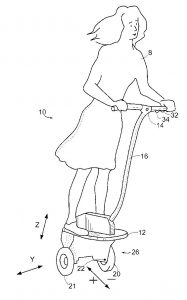Trademark Infringement Findings in ITC Investigations Without Actual Confusion or Consumer Survey Evidence
Over the past few years, Segway, Inc., the maker of two-wheeled motorized personal vehicles (as seen in U.S. Patent No. 8,830,048) has successfully litigated against competitors that were infringing its patents.

In March 2016, Segway won the rare remedy of a General Exclusion Order (GEO), issued by the International Trade Commission after an investigation concluded in findings that several companies were infringing certain claims of Segway’s patents. The GEO prohibited anyone, whether or not they were named as an accused party in the investigation, from importing into the United States certain personal transporters that infringe certain claims of Segway’s U.S. Patent No. 8,830,048. The ITC also issued a limited exclusion order prohibiting certain companies from importing certain personal transporters, components, and manuals that infringed claims of Segway’s patent.
Two months later, Segway filed another complaint with the Commission, this time against Swagway, LLC, for patent and trademark infringement. The marks, U.S. Trademark Registration Nos. 2,727,948 and 2,769,942, are for the non-stylized SEGWAY mark, which covers “motorized, self-propelled, wheeled personal mobility devices, namely, wheelchairs, scooters, utility carts, and chariots,” and the stylized version of the SEGWAY mark covering the same goods as its non-stylized counterpart. Segway alleged that Swagway’s self-balancing hoverboard products, marketed under the names SWAGWAY X1 and X2, as well as SWAGTRON T1 and T3, infringed Segway’s registered trademarks. Segway later filed another complaint with the ITC naming additional respondents as accused infringers of the same patents and trademarks. The ITC instituted investigations based on both complaints and consolidated them.
By the time of the final hearing, two of six originally asserted patents and the two trademarks remained. Although the presiding Administrative Law Judge found no infringement of the patents and that Segway had not satisfied the technical prong of the domestic industry requirement, the ALJ concluded Swagway’s use of the SWAGWAY designation, but not the SWAGTRON designation, infringed both trademarks.
The Commission affirmed the ALJ’s findings, and Swagway appealed to the United States Court of Appeals for the Federal Circuit. According to Swagway, the Commission should not have found trademark infringement because (1) there was no evidence of actual confusion and (2) Segway failed to offer consumer survey evidence, which failure Swagway argued should have been held against Segway.
The Federal Circuit affirmed the Commission’s decision, notably holding that the finding of trademark infringement was appropriate even though evidence of actual confusion “did not weigh in favor of likelihood of confusion,” and Segway did not offer any consumer survey evidence.[i]
In the U.S., to prove trademark infringement a trademark owner must show a “likelihood of confusion,” i.e., that consumers would likely confuse the alleged infringer’s mark with the asserted mark. To determine whether a likelihood of confusion exists courts typically consider the non-exclusive list of factors set out in In re E.I. DuPont DeNemours & Co., 476 F.2d 1357 (C.C.P.A. 1973), known generally as the DuPont factors. Although the DuPont case focused on likelihood of confusion in the context of trademark registration, the U.S. Supreme Court recently decided that these factors also apply to trademark infringement.[ii]
The DuPont factors are:
- The similarity or dissimilarity of the marks in their entireties as to appearance, sound, connotation and commercial impression.
- The similarity or dissimilarity and nature of the goods or services as described in an application or registration or in connection with which a prior mark is in use.
- The similarity or dissimilarity of established, likely-to-continue trade channels.
- The conditions under which and buyers to whom sales are made, i.e. “impulse” vs. careful, sophisticated purchasing.
- The fame of the prior mark (sales, advertising, length of use).
- The number and nature of similar marks in use on similar goods.
- The nature and extent of any actual confusion.
- The length of time during and conditions under which there has been concurrent use without evidence of actual confusion.
- The variety of goods on which a mark is or is not used (house mark, “family” mark, product mark).
- The market interface between applicant and the owner of a prior mark.
- The extent to which applicant has a right to exclude others from use of its mark on its goods.
- The extent of potential confusion, i.e., whether de minimis or substantial.
- Any other established fact probative of the effect of use.
The ITC need not consider every factor; only those factors supported by evidence in the record should be addressed. Other relevant factors not specifically enumerated may also be considered in appropriate circumstances.
In the ITC’s Swagway investigation, the ALJ evaluated six factors based on evidence in the record: actual confusion; the intent of the actor in adopting the designation; the relation in use and manner of marketing between the goods and services marked by the actor and those by the other; the degree of similarity between the designation and the trademark; the strength of the mark; and the degree of care likely to be exercised by purchasers. The ALJ then concluded there was trademark infringement due mostly to a strong showing of actual confusion and the degree of similarity between the designation and the trademark. On review by the Commission, the Commission disagreed with the ALJ’s finding that there was “overwhelming evidence” of actual confusion and instead found a lack of such evidence. That did not, however, change the ultimate finding that Swagway infringed both trademarks with its SWAGWAY designation.
Swagway appealed the ITC decision on several grounds, including challenging the ultimate finding of trademark infringement in what Swagway believed was an absence of sufficient evidence and an error in the weight given to the DuPont factors.
First and foremost, Swagway argued the ITC should have viewed the lack of actual confusion evidence as essentially conclusive in this case. According to Swagway, the lack of actual confusion evidence was particularly probative in this case because the products bearing the registered trademarks and the allegedly infringing products were sold concurrently over a substantial period of time (a DuPont factor not considered by the ALJ).
The Federal Circuit disagreed. The Court first clarified that while the DuPont factors recognize concurrent use as being relevant when there is no evidence of actual confusion, it has never been the case that concurrent use always bars a likelihood-of-confusion finding. Although evidence of concurrent use weighs against a likelihood of confusion, such evidence must be balanced against other evidence of record.
The Court also clarified that the ITC’s decision was not that a lack of actual confusion evidence “cannot in any circumstance weigh against a likelihood-of-confusion finding,” it was that the ITC found that the lack of actual confusion evidence in this case “d[id] not weigh in favor of a finding of a likelihood of confusion.” Apparently Swagway did not argue on appeal that the evidence it presented to the ITC should have resulted in a finding of long-term, concurrent use in the same channels of trade. Therefore, according to the Court, Swagway had not established that the absence of actual confusion evidence should have weighed against a finding of likelihood of confusion in this case.
Swagway also complained on appeal about the ITC’s failure to weigh Segway’s failure to submit survey evidence against a likelihood-of-confusion finding. Swagway argued that because Segway had the financial means to conduct surveys and chose not to, that failure should have created “an adverse inference that such a survey would not have shown a likelihood of confusion with respect to the asserted trademarks.”
Again, the Federal Circuit disagreed. The Court unequivocally announced that consumer survey evidence is not required to show a likelihood of confusion. The Court also noted this was not the first time it had been invited by a litigant to apply an adverse inference against a party alleging infringement for failure to present survey evidence; and as it did before, the Court declined to apply such an inference. The Court therefore held the ITC did not err in according no weight to Segway’s lack of survey evidence.
Finally, Swagway also argued that the ALJ failed to properly consider a proposed consent order that accompanied a motion to terminate the investigation, in which Swagway was seeking to terminate the investigation in part by agreeing not to import products bearing the SWAGWAY designation into the U.S. The ALJ did not grant the motion to terminate and did not give an explicit reason as to why in his written decision. The Commission declined review of the denial, finding no error in the ALJ’s disposition. On appeal, the Federal Circuit found no error in the ALJ’s actions either.
This case highlights how a trademark owner can still win an infringement suit even in the absence of significant evidence of actual confusion and even in the complete absence of consumer survey evidence, provided the trademark owner provides sufficient compelling evidence of other DuPont factors. This case also serves as a reminder to litigants seeking to “settle out” of an investigation how important it is to do so as early as possible to ensure consideration of a motion to terminate and proposed consent order.
For more information or question about International Trade Commission investigations, please feel free to contact Tammy Dunn at dunn@oshaliang.com.
[i] Swagway, LLC, v. International Trade Commission, No. 2018-1672 (Fed. Cir. 2019) (modified Aug. 14, 2019).
[ii] B & B Hardware, Inc. v. Hargis Indus., Inc., 135 S. Ct. 1293, 1307 (2015).




